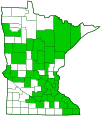black giant ichneumonid wasp
(Megarhyssa atrata)
Conservation • Description • Habitat • Ecology • Distribution • Taxonomy
|
|
|||||||||||||
Description |
Black giant ichneumonid wasp is a common parasitic wasp. Its large size and bright coloration make it one of the “charismatic megafaunas” of the insect world. It occurs in the United States from Maine to Florida west to North Dakota and eastern Texas, and in adjacent Canadian provinces. It is common in Minnesota. It is found in deciduous forests and woodlands. Larvae prey on the larvae of pigeon tremex in dead and decaying hardwood trees. Adults are seen in June and July. They do not feed. Adults are large, slender, and long-legged. Females average 1½″ (38 mm) in length. Males are smaller, averaging 1⅜″ (35 mm) in length. The thorax and abdomen are black. The head is rounded-triangular and mostly yellow. There are two large compound eyes on the sides of the head and three small simple eyes (ocelli) in a triangle near the top of the head. A narrow dark band runs between the compound eyes and through the occeli. The antennae are thread-like, have at least 16 segments, and are straight, not elbowed. They are 15⁄16″ (24 mm) long and yellow on the female, ½″ (13 mm) long and dark brown on the male. The bases of the antennae are black. The plate over the upper lip (clypeus) is small, squarish, and flattened. The face and clypeus form a smooth convex surface with no groove. There is often a black spot on the face just above the clypeus. The jaws (mandibles) are short and stout. The thorax has three segments. The upper plate on the first segment (pronotum) is more or less triangular and extends nearly to the small plates (tegulae) covering the wing bases. On the female the thorax is black and shiny. There is a yellow dash in the middle of the metascutellum and sometimes a small yellow spot in the shoulder (humeral) area but there are rarely any other yellow markings. On the male the plate on the side of the middle segment (mesopleuron) has a yellow spot below the wing insertion and additional yellow markings, and the upperside has yellow lines and spots. There are breathing pores (spiracles) running the entire length of the thorax. The abdomen is long, cylindrical in front becoming flattened in the rear. Segments 2 and 3 are separate, not fused together, with a pair of spiracles on each segment. Segments 2 through 5 are hardened and rigid. On the female, the abdomen is black with no yellow markings, segments 8 and 9 are elongated, the tip is modified as a horn, and a long needle-like tube (ovipositor) projects from the tip. The ovipositor is dark brown and 5″ to 6″ (12.7 to 15.24 cm) long, about 3.7 times as long as the forewing, and at least 5 times the length of the fourth segment (tibia) of the hind leg. Abdominal segments 2 through 6 each have a pair of raised projections (tubercles) close to the front lower (sternal) margin. These act as guides for the ovipositor when drilling into wood. Within the expanded tip of the abdomen there is an expandable membrane that helps the female extract her ovipositor from the wood. When deployed it is white, translucent, circular, and about ¾″ in diameter. The black abdomen and mostly unmarked black thorax is the feature that gives the species part of its common name and distinguishes it from all other Megarhyssa. On the male the abdomen is very dark brown to black, and there is a yellow mark on the rear margin of the first segment. The wings are long, narrow, clear, and tinged smoky brown. On the forewing the costal and radial veins are fused so that there is no costal cell. The base of the cubital (cu) vein is lacking. There are two recurrent (backward-turning) veins forming a cell. The first submarginal cell and the first discoidal cell are fused into a single large discosubmarginal cell. The shape of the discosubmarginal cell is said to resemble a horse’s head and is sometimes called the “horsehead cell.” The small second submarginal cell (areolet) near the center of the wing is triangular and is connected to the Rs vein by a short cross vein (petiolate). On the hindwing, the radial sector-medial cross (rs-m) vein joins the radial sector (Rs) vein after the split between the Rs and R1 veins. The subbasal cell is closed. The legs are long, slender, and mostly yellow. The second segment (trochanter) is two-segmented. On the middle legs the second of these segments (trochantellus) has a longitudinal ridge. The trochanter on the middle and hind legs and the first segment (coxa) on all legs are black. The coxa on the hind legs is long, 2.3 times longer than wide. The tibiae on the front legs do not have a tooth on the upper side at the tip. The claws at the tip of the last segment (tarsus) of each leg are simple, not split. |
Size |
Female: average 1½″ (38 mm) Male: average 1⅜″ (35 mm) |
Similar Species |
Habitat |
Deciduous forests and woodlands |
Ecology |
Season |
One generation per year: June and July |
Behavior |
It takes about an hour for the female to drill into wood, deposit an egg, and extract her ovipositor. During this time she is vulnerable to predation and is easily photographed. |
Life Cycle |
The female locates a pigeon tremex grub by tapping the bark with her antennae. When located, she drills her ovipositor into the wood up to 5½″ (140 mm) deep and deposits a single egg on or near the grub. When the egg hatches the larva consumes the grub. It pupates in the burrow and the adult emerges in the spring. Males emerge first. They locate females by the sound of the female larva chewing an escape tube into the wood. They usually inseminate the female before she emerges. |
Larva Food |
Pigeon tremex larvae |
Adult Food |
Adults do not feed |
Distribution |
||
|
Sources |
|
| 7/12/2024 | ||
Occurrence |
||
Common |
||
Taxonomy |
|
Order |
Hymenoptera (Ants, Bees, Wasps, and Sawflies) |
Suborder |
Apocrita (Narrow-waisted Wasps, Ants, and Bees) |
Superfamily |
Ichneumonoidea (Ichneumonid and Braconid Wasps) |
Family |
|
Subfamily |
Rhyssinae |
Genus |
Megarhyssa (giant ichneumonid wasps) |
Subordinate Taxa |
|
|
|
Synonyms |
|
Ichneumon atratus |
|
Common Names |
|
black giant ichneumonid wasp black giant ichneumon wasp |
|
Glossary
Clypeus
On insects, a hardened plate on the face above the upper lip (labrum).
Ocellus
Simple eye; an eye with a single lens. Plural: ocelli.
Ovipositor
A tube-like organ near the end of the abdomen of many female insects, used to prepare a place for an egg and to place the egg.
Pronotum
The exoskeletal plate on the upper side of the first segment of the thorax of an insect.
Spiracle
A small opening on the surface of an insect or arachnid through which it breathes.
Tegula
A small, hardened, plate, scale, or flap-like structure that overlaps the base of the forewing of insects in the orders Lepidoptera, Hymenoptera, Diptera, and Homoptera. Plural: tegulae.
Tibia
The fourth segment of an insect leg, after the femur and before the tarsus (foot). The fifth segment of a spider leg or palp. Plural: tibiae.
Tubercle
On plants and animals: a small, rounded, raised projection on the surface. On insects and spiders: a low, small, usually rounded, knob-like projection. On slugs: raised areas of skin between grooves covering the body.
Visitor Photos |
||
Share your photo of this insect. |
||
This button not working for you? |
||
Jennifer Stoops |
||
 |
 |
|
found on our front door this morning. I had never seen one before here! |
|
|
 |
|
|
Trecia |
||
 |
|
|
This thing flew into our church. We've never seen anything like it before. |
|
|
Jon Nicholson |
||
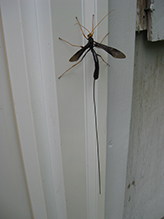 |
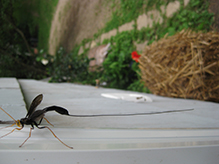 |
|
| Giant ichneumonid wasp on my doorframe. |
|
|
MinnesotaSeasons.com Photos |
||
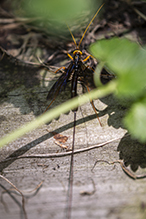 |
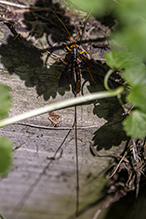 |
|
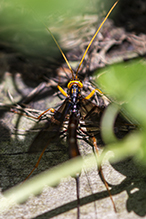 |
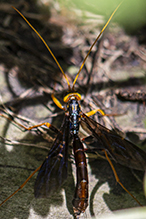 |

Slideshows |
|

Visitor Videos |
||
Share your video of this insect. |
||
This button not working for you? |
||
|
Other Videos |
||
Megarhyssa atrata |
About
Aug 24, 2019 Oviposition into a Beech. |
Giant Wasp Drills Through Tree to Parasitize Other Wasp's Larva |
About
Oct 23, 2020 A Giant Ichneumon Wasp, Megarhyssa atrata female drills her long genitalia through the trunk of a tree to sting and paralyze the larva of a horntail wood wasp deep below the surface. Her egg will go onto to hatch and consume the wood wasp larva before emerging the following summer as an adult. www.insectslimited.com |
Giant Black Ichneumon Wasp Megarhyssa atrata ovipositing |
About
Nov 27, 2014 Giant Black Ichneumon Wasp (Megarhyssa atrata) ovipositing. The wasp is almost 2" long and has one of the longest ovipositors in the insect world, much longer than its body. It curls up in an expandable section of the abdomen, apparently for stability or traction as it drills into the tree to lay an egg on a host, usually a horntail wasp larva. photo gallery at: |
Giant Ichneumon Wasps (Ichneumonidae: Megarhyssa atrata) Dead Females |
About
Jul 9, 2011 These female ichneumon wasps are but two of innumerable harmless insects that were killed inadvertently, as non-target species, in an effort to reduce the mosquito population using fogged adulticide the previous evening at TRSP. Photographed at the Turtle River State Park, North Dakota (08 July 2011). |
'Megarhyssa atrata', Giant Ichneumon Wasp |
About
Aug 6, 2015 Digital video clip of a female 'Megarhyssa atrata', or Giant Ichneumon Wasp, ovipositing eggs into a .5 cm. borehole in a section of large dead Slippery Elm tree, and likely onto the host larva, 'Tremex columba', or Pigeon Horntails. Captured on 8/6/15 in Kalamazoo, Michigan. |

Visitor Sightings |
||
Report a sighting of this insect. |
||
This button not working for you? |
||
Jennifer Stoops |
Location: Mackinaw, IL found on our front door this morning. I had never seen one before here! |
 |
Trecia |
Location: Knoxville, TN This thing flew into our church. We've never seen anything like it before. |
 |
| Mark Petruzzi 8/20 /2023 |
Location: Cape Cod, Ma – West Yarmouth Appears to be living in brass hollow chimes on back deck |
|
| Jon Nicholson 7/13/2017 |
Location: Winona County, New Hartford Township, MN Giant ichneumonid wasp on my doorframe. |
 |
MinnesotaSeasons.com Sightings |
||

Created: 1/17/2022 Last Updated: © MinnesotaSeasons.com. All rights reserved. |
